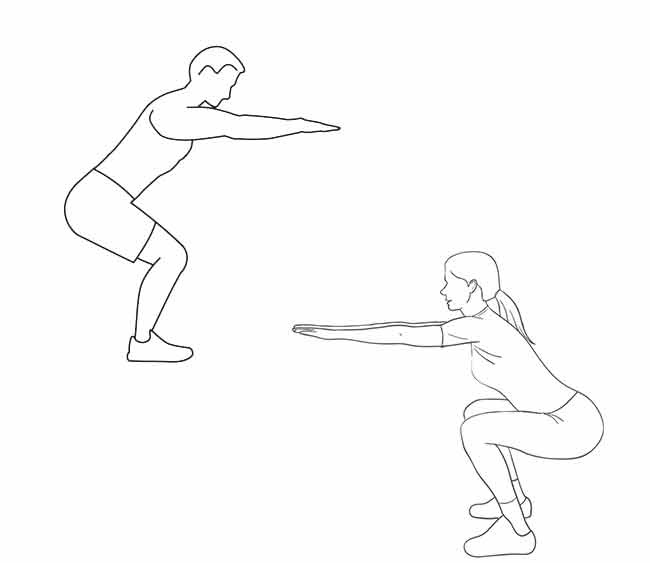
Fit for duty: October 2015
Sherry Dean
Features Fitness Health and WellnessHow do I start lifting weights? What are the best exercises to learn? How do I know if I am doing things properly? These are questions that everyone who works out had to learn at one time. Some folks had a friend or professional help them at the beginning, but for many people a strength program is daunting and frustrating, and often leads to quitting.
 Squats: women 50% body weight – men 70% body weight How do I start lifting weights?
Squats: women 50% body weight – men 70% body weight How do I start lifting weights?Employing a personal trainer is one of the best means to help you with a specialized program, but doing so is not always feasible. Be very careful whom you ask for advice. Just because someone has been lifting weights for years does not mean he or she is a good source of information. If you have a trusted source, use it, but make sure it’s a credible source. The Internet is loaded with good advice, but be selective and find out the website’s credentials.
The following are must-do exercises that help with overall strength, and are a great way to build your foundation for other exercises. Once you have good form and can complete these, you should be ready to add to your repertoire.
Maintaining proper form is a must. If you have to cheat to lift, lower the weight you are using. Build the foundation of your exercise before you add more weight. Improper form leads to injury. If you hurt while you are doing an exercise, chances are you are doing something wrong and should make adjustments.
Back squat
There are many myths about squatting: it’s bad for your knees, it’s bad for your back, you should only squat to 90 degrees, and so on. Squats are great – they target quads, hamstrings, glutes and core muscle groups – but they are hard. Don’t avoid them. You may not be able to squat to parallel at first, but you should aim to get below parallel for the best results. Keep your glutes and core activated. Your knees should be pressing outward over your feet and not caving into the middle. Press from your heals and keep your head up.
Always keep in mind your individual restrictions. If you have a knee or back injury, consult a professional. However, as a firefighter, you need to consider whether you are fit for what is necessary on scene.
First-time squatters should aim to complete 10 to 15 reps. Women should begin with approximately 50 per cent of their body weight and men about 70 per cent. If in doubt, go lighter, but add weight when you can complete a set without difficulty.
Pull-up/chin-up
Even for some men, a proper pull-up is challenging, but you can definitely get there. Start with a close grip, palms facing you (chin-up), which should be an easier exercise than a wider grip with palms facing away (pull-up). If you cannot do a pull-up, either jump to raise your chin above the bar or use a bench to step up and do a negative rep. Slowly lower yourself down, then jump or step back up and repeat. Challenge yourself by pulling up as far as you can or hanging in an isometric contraction (not moving, but pulling up) for as long as you can.
There are exercise bands you can hook under your feet for assistance, or if you have a partner, he or she can take some of your weight by holding your feet (knees bent).
You want to eventually begin the rep with fully extended arms and your body completely hanging below the bar. No bent elbows! Complete your pull-up by raising your chin – or better yet, your chest – above the bar.
If you can complete five consecutive pull-ups, add a five-pound weight and work up from there.
Push-up
There are many forms of push-ups such as spider mans, pikes, varied widths, moving, and so on, so you won’t get bored with the variations.
Do not start from your knees; get them off the floor and do a negative lower, nice and slowly, just as you did with your pull-ups. You can push-up against a wall or a table to change your angle until you can get those knees off the ground.
Work at increasing the number of consecutive push-ups and aim for 30. Once you can complete 30, begin changing it up. Move your hands closer or farther away, take one of your feet off the floor or hold a plank at the bottom of each push-up. Try everything.
Cardio
Don’t forget about your cardio. I know, I know you hate cardio! Too bad – do it anyway. Pick something you like, but work hard at it. Bike, jog, ice skate, swim, it doesn’t matter, just do it at a rate that makes you breathe hard for at least 15 minutes. Use interval training to improve your effort. For example, go hard for one minute followed by a one-minute recovery, then work up to two minutes high intensity, one-minute recovery, and so on. Before you know it, you’ll be invincible.
Stay fit and stay safe!
Sherry Dean is a career firefighter/engineer with Halifax Regional Fire & Emergency Service. She has more than 20 years of experience in fitness and training. deansherry@bellaliant.net
Print this page